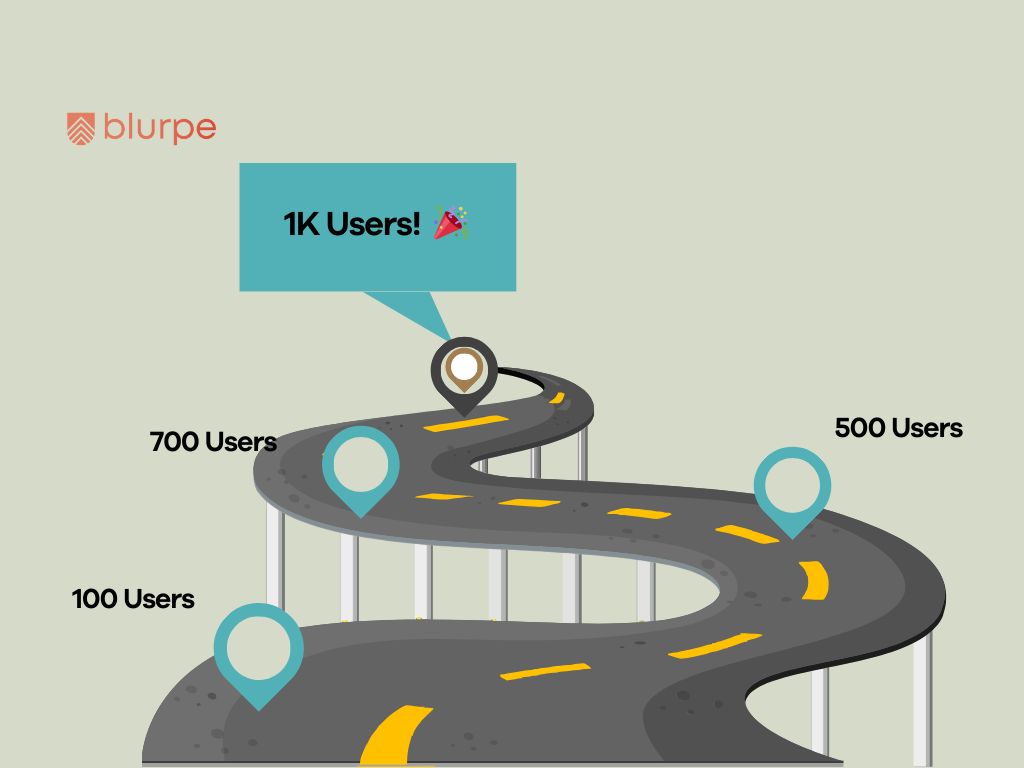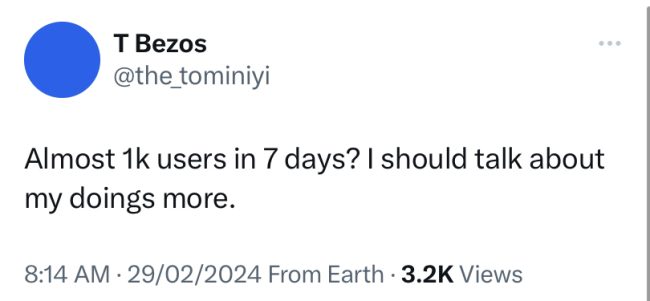There are a lot of articles and think pieces on how to get your first 1000 users. It’s the most popular topic for startup founders and product marketers. So it only made sense that we had to get on it when we bumped into a tweet on X claiming almost 1k users in 7 days.
Almost everything you find online is theoretical and we get it. People have beautiful ideas about how to get your first set of users_ some of them include harassing friends and family_ which is good for your loved ones because they get a stake in the “I was there in the early days” claim. While you get a few number of users—a win-win.
The best thing to do with helpful information in the internet age is to share it. And that is what we’re doing. We spoke to Tominiyi, the product marketer who shared the tweet. What you are about to read contains strategies that brought in almost 1k users for a startup still in beta.
The best part? You’ll need to ditch the popular industry hot takes. This is the real deal.
A lot happens behind the scenes
The first thing Tominiyi hammered on was that she wasn’t the only one who did the work. “Our product team is pretty solid”, that’s how she put it. What attracted us to the tweet was the result but we would learn (like you would) that months of hard work had gone into the result that was now visible. With even more work to come for better results shortly.
For starters, priority number one was identifying the problem. They weren’t interested in the usual recipes most startups seemed to indulge themselves in. If they were going to market their solution to users, they would do it by ensuring that their solution was what people wanted. The first step in their game plan? A perfect understanding of the problem from their target audience’s point of view.
“A solution is only as good as the understanding of the problem you’re addressing”, Tominiyi said. Every community where they could find their target audience, she joined. From Facebook to Telegram, learning more about the people they were building for. For a set duration, the goal was to keep tabs on how their audience interacted on a day-to-day basis.
“We had to validate the problem before validating the solution. We did that by being wherever they were and getting to know them. The communities I was joining were a far cry from my regular life. Still, the goal was to engrain myself with knowledge of what our T.A was facing and how the solution we were building could come in”, these were the words Tominiyi reeled out when she tried to explain the importance of understanding the reason for building, in the first place.
Dispelling the misplaced notion of building first and attracting users later. For the startup this was what validated the problem and their solution, formed the profiles of their users and as you would later see provided an entry point for their acquisition.
Well-crafted messaging, Strategic Infiltration and Touchpoints.
Tominiyi and her team had mastered the art of blending in with their potential users such that when they crafted their message, it mirrored what their target audience described as the perfect solution to the problem. Every target audience-filled community became a touchpoint.
The thing with touchpoints is that there are a lot of myths. Where you can find a certain range of people (age, gender, occupation etc) and what platform you can find them on. Well, Tominiyi called it for what it was. Sometimes, Bullcrap.
“Go wherever you can find your audience. Online, your competitors’ page and other times, it’s your instinct telling you to do something. You do it. Nothing is set in stone when it comes to achieving your goals”, she said. The latter part stood out especially because it counters many age-long marketing fanatics. But if you think about it, that is exactly what makes marketing a thrill! Your gut feeling remains an unbacked assumption if you don’t follow it up with work and results to show for it. And it’s clear, for this startup, it wasn’t just an assumption.
This startup made a strategic entrance using community collaborations. They presented a solution that had been in the same online forum as their target audience for weeks on end. The right messaging at the right place. It only makes sense to go with what you’re familiar with. This is marketing at its finest. Not forced. Not necessarily over the top. It was at best, the most familiar thinkable solution. Understanding the market had given them room for market penetration. However, market entry is not the same as user acquisition.

Segmentation and Targeting
This is where the technicality comes in. For Tominiyi and her teammates, they knew they could rightly cater to a large audience. But that might have spelled doom so instead what they did was segment their audience based on what they had learned so far from close interaction with them. “So we picked pain points of different categories of our target market and of course, it had to align with our business goals”, she explained and this set the ground for targeting their users.
“It dictated what angle we were going to come from and guided our comms to the particular segment we were targeting” she added as she explained how a deep segmentation of their target audience helped capture their attention and streamline their value proposition to directly fit the bill they needed. For her, catering to multiple segments at once can lead to a confusing product offering especially because your target market is at different stages and would need your product for different purposes. But she added a disclaimer, “it depends on the industry”.
What worked better was operating with a system that answers to one category, targets another, caters to them and does a rinse-and-repeat style until you have consumed all segmentations. That’s what brought in almost one thousand users. A working theory that can lead to further modification of the product.
What Was Their Funnel Strategy?
The best ingredients neatly prepped in small neat bowls are still just ingredients. You need a recipe to turn it into a mouth-watering meal. “Nobody is just sitting down, waiting to download the newest app”, she said as she started to explain how they directed their audience into real-time users.
They were already top of mind following collaboration with communities and consistent interaction. So they set up a sales page. You see, there’s no jumping over the stage where you directly sell yourself to your potential users. A sales pitch containing everything their potential users could get from using their product. Every feature is explained, and every benefit is pronounced clearly without mincing words. The delight is, that it came in an exclusive package.
“We didn’t need a whole lot of people even though we could have gotten more”, she said. The people who went through the sales page and were sold were transferred to an email list. There was already an email containing a link to download the app while re-inforcing their product offering. What you’re seeing is a simplified funnel changing the game.
The future involves people falling off funnels that are too complex, long and lack tactical hold over their attention. It either has to be short and a hit or long, captivating and a hit. Either way, the end game has to involve hitting the mark. Keep in mind that this is a guide _story_ on acquisition in a matter of days (plus behind-the-scenes work).
Marketing Metrics To Track
We’ll be fair with you, this was a difficult question for her to answer. You might have noticed the hush we’ve kept as regards the name of the startup. It’s because they’re still in beta. Still, a solid take given in the course of the interview was to narrow down the metrics.
Only metrics important to acquisition matter. Nothing more, nothing less. “We had different channels of acquisition, both paid and organic. For the paid traffic, we added UTM links to the ads we set and attached trackable links to the community and content creators we partnered with”, Tominiyi said.
For her, these were necessary metrics to monitor because they would also inform future advertising decisions. Knowing which channels converted more and which outrightly failed helped her tweak what was needed and move on from what was not. Views, Click through rate, Email open rate, Sign up rate… Those were the numbers that mattered.
Not everyone bought what they sold though, “people dropped off o”, she exclaimed but as much as they dropped off, they doubled down on their various touchpoints (community, ads, creators, social media) ensuring that people were trooping in their numbers.

Some Marketing Myths Were Ditched
If anything, the team were not a fan of “never-changing rules”. Evolution is the order of the day. It rings true for every industry. We threw the question to Tominiyi asking what marketing strongholds she and her team ditched.
The response will serve as a big win for bootstrapping startups. “We ditched the idea that a buck load of money must be spent to get people. Every money we spent was accounted for. We did spend but we were very bullish about getting results as well”, she said with vigour. The same vigour that went into months of private work, seven days of amassing 1K users and about 2-5 seconds of making the tweet that drew our attention. What they didn’t spend in money, they spent in time. “You have to be willing to play the long game”, she added.
The next myth that fell shamelessly into the gutter was the one of garnering millions of users only to see them churn later. Tominiyi insisted that retention is the name of the long-term game. “We wanted the right people. We knew the quality of people we got would build the platform and that is what we went for”. Not to start a ruckus but notable examples were made to prove her point of amassing millions of downloads only to churn at the speed of lightening later on. Without mincing words, we saw her point.
Plans for Retention and Scalability
According to Tominiyi, the plan is to make sure that their value proposition stays at the forefront of their users’ minds. Engaging their users with push notifications and community moderation. She also added that they had already started user interviews to gain more insight into what their current users like about the app.
On scaling, she said, “We’re already working on another strategy for the next customer segment. We’ve seen what one segment can do, we are serving them already”. There’s a popular saying “No rest for the wicked”, while Tominiyi and her teammates might not be wicked, there’s certainly no rest in sight for them, at least not yet. The first 1,000 users usually lead to much bigger goals.
Mistakes Made and Lessons Learned.
You know, we know, everybody knows that mistakes are inevitable. One of the mistakes Tominiyi made was not setting up app analytics which caused them to migrate from one software to another in the middle of acquisition.
“Also from the product end, there was a lot of “please update your app” and that wasn’t supposed to be so”, she stated. Despite that, it looks like they pulled their weight and made it work. “I think in retrospect a lot of mistakes were averted because we have a CEO that had a good understanding of marketing and it was refreshing to experience”, this was an addition that shed more light on the process and results.
Final Takeaway
It is only fair that at the end of all this, you have something that resonates with you. Here it is: “The solution can only be as good as your understanding of the problem”, you already know who that came from. The more you grasp about the problem you aim to solve, the better your solution will be. When you think about it this way, it increases the likelihood and speed of acquiring your first 1000 users.

